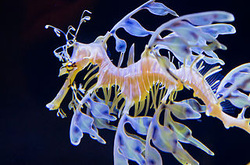|
The Californian animal that made the greatest impression on me was the pelican. I first encountered them idling and preening on the rocks at La Jolla, occasionally rousing themselves to a brief and graceful flight across the bay. But what really gripped me was their homeward flight to roost at dusk on Pacific Beach. They’d fly up like a military formation, perhaps 30-40 birds in constantly shifting patterns, often in the classic asymmetrical V with five or so birds in the short arm and the rest more or less straight behind. But they would playfully slip and slide out of this pattern, sometimes a kink ravelling down the whole formation, sometimes the V evening out to a swept-wing formation, sometime all line astern. Sometimes a bird or two would break off and fly out to sea. The whole spectacle conveyed such a sense of power and purpose and an enviable sense of community and purposeful life. At La Jolla they had been wet-suit divers swimming with the seals in mammalian fellowship but it was the pelicans that spoke to the animal spirits in me.
 San Diego gave me the chance to see for the first time live what is probably my favourite animal: the leafy sea dragon. When I first became interested in camouflage and mimicry the sea dragon grabbed my attention as one of nature’s finest whimsies. A cousin of the much better known sea horses, the sea dragons are fishes that live amongst seaweed and camouflage themselves with many floating excrescences that perfectly match the drifting swags and fronds of their environment. Their elongated snout gives them a very strong facial character and the impression the animal creates is that of a punk jester in tattered raiment. Leafy sea dragons are not Californian natives: I saw them in the Birch Aquarium at the Scripps Institute for Oceanography but they are only found in the wild off southern Australia. My first sight of a live, swimming sea dragon was a surprise because they are usually yellow bodied with green appendages but the aquarium animal was almost transparent: they can colour match to their surroundings and the tanks they were kept in were relatively colourless. The oddities of sea dragons don’t stop with their camouflage. Most notably, the male broods the young on brood patches on the tail. They are, of course, threatened and the Scripps Institute has a program to breed them in captivity. A week in San Diego provided a riot of impressions. The flora of California is a wonder with desert staples mixing with coastal flowers, flowering trees, palms and pines and extravagant tropical exotics. It is an Aeonium paradise with rosettes of all sizes beaming out in profusion. California is also hospitable to other warm climate flowers such as the Ice Plant from South Africa with abundant large yellow flowers with triangular fleshy leaves. The cliffs at La Jolla are rich in magnificent drifts of colour, some of which proved to be great banks of nasturtiums. Who would have thought the English suburban favourite could appear so Californian?
Ever since I discovered the amazing technical properties of spider silk (recounted in my book The Gecko’s Foot) I’ve had a soft spot for the garden orb spider. We have a small but spider-friendly garden – a tall honeysuckle, plenty of shrubs and perennials and not much done to disturb it from early summer through to autumn – and I try to look after the spiders once they set out their stall. Last year, though, was pretty disastrous for them, with numbers well down.
This year, though, they’re back with about ten large spiders setting out their stall most days. This year I’ve seen a couple of events I’ve never witnessed before. The largest spider in the garden was responsible for both. Firstly, the very large creature bundled up in the web one morning looked suspiciously like another garden spider. I didn’t disturb it to check but by size and markings it seemed to fit the bill. And today I saw a battle between the spider and a bee. For a couple of minutes it looked as if the spider would immobilise the bee: it furiously turned the bee over and over, following it down the web as the bee tried to escape. But the bee was just too big and eventually flew away. The spider, large though she is, must have wasted a lot of energy on that. Most days, though, they don’t do much, except hang there, getting slowly bigger. Occasionally, I catch one repairing the web and that’s always a delight. Even when they’re motionless, the subtle markings on the large ones always give pleasure. It’s strange, given that many spiders are not prepossessing, just how elegant the garden orb spider is. . |
AuthorI'm a writer whose interests include the biological revolution happening now, the relationship between art and science, jazz, and the state of the planet Archives
March 2016
Categories
All
|
 RSS Feed
RSS Feed
